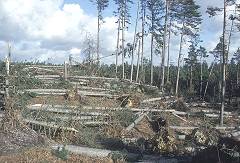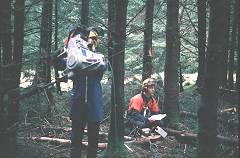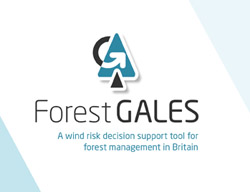Summary
Summary
 Recent research has improved our understanding of the fundamental processes involved in windthrow. The tree stability and wind risk project provides management tools, advice and knowledge to reduce wind damage to British forests.
Recent research has improved our understanding of the fundamental processes involved in windthrow. The tree stability and wind risk project provides management tools, advice and knowledge to reduce wind damage to British forests.
The threat of wind damage is widely recognised to be a serious constraint to the management of British forests. Major storms have caused volumes of timber in excess of 1 million m3 to be damaged at least five times in the last 50 years. The risk of windthrow is a major determinant of rotation length in upland areas and thinning programmes are constrained in over 50% of regions because of wind damage. Wind damage is believed to cost countries in the European Union approximately 15 million Euros per year, and on occasions substantially more. For example, storms in Northern Europe in December 1999 overturned more than 300 million m3 of timber and in January 2005 overturned more than 85 million m3 of timber.
 Past tree stability research in Britain was influential in the choice of rotation lengths and thinning practice. It has also influenced the choice of operational techniques, such as the move towards use of mounding as an establishment technique for afforestation and restocking, and the abandonment of late mechanical thinning on vulnerable sites.
Past tree stability research in Britain was influential in the choice of rotation lengths and thinning practice. It has also influenced the choice of operational techniques, such as the move towards use of mounding as an establishment technique for afforestation and restocking, and the abandonment of late mechanical thinning on vulnerable sites.
The fundamental processes involved in windthrow include the interaction of trees and wind, the interaction of roots and soil, and the interaction of wind and topography.
Over recent years a major success has been achieved through the synthesis of tree stability and wind climate knowledge into a computer-based model, ForestGALES, to guide forest managers on the risks of wind to conifer plantations.
Research objectives
We are working towards the goal of modifying ForestGALES to enable it to calculate the risk of wind damage to ‘alternative silvicultural systems’ and mixed species stands.
The main current research objectives are:
- To understand the interaction between wind, topography and trees and the effect of temporal variability in extreme wind occurrence
- To improve the representation of the British wind climate in ForestGALES
- To examine the interactions between the physiological development of roots and soil properties
- To develop improved relationships between anchorage and tree dimensions, separated between species, soil group and rooting depth
- To develop a new wind risk model which deals with the risk to individual trees. This will allow calculation of the risk to species mixtures and where alternative silvicultural systems are used.
Funders and partners
![]()
This research is predominantly funded by the Forestry Commission.
![]()
The European Commission funded work in the ECOSLOPES project on tree stability, and the potential for soil loss, on complex terrain. Another EC project, EFORWOOD, examined wind as an abiotic risk within a Sustainability Impact Assessment of the Forestry – Wood Chain. Windthrow scenario modelling and a development of a research version of ForestGALES were funded as part of the EC Interreg North Sea Region STORMRISK project.

Publications
- The principles of using woods for shelter
Forestry Commission Information Note 81 - Designing forest edges to improve wind stability
Forest Commission Technical Paper 16 - Cultivation of soils for forestry
Forestry Commission Bulletin 119 - Climate change: impacts on UK forests
Forestry Commission Bulletin 125 - Forests and wind: management to minimise damage
Forestry Commission Bulletin 114
Status
The “wind risk” work area is part of the Assessing Resilience programme 2015-2019.
Contact
General Content
What’s of interest

ForestGALES
A PC and web-based decision support tool that enables forest managers to estimate the probability of wind damage to any conifer stand in Britain.
